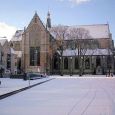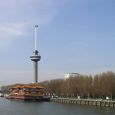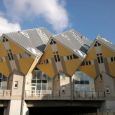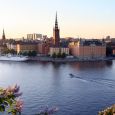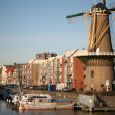Rotterdam
Advertisement
By Air
Rotterdam Airport is a relatively small airport located just north of the city and mainly operated by low-cost carriers and some charter flights. Transavia fly between Rotterdam and London Stansted, Geneva, Hamburg, Nice, Faro, Rome and a few other smaller destinations.
Bus number 33 travels from the airport to Central Station, leaving every 10 minutes, with a journey time of 20 minutes. There is also a shuttle service from the airport to Amsterdam, The Hague and Delft. Taxis and car hire are readily available from the airport.
By Ferry
Rotterdam is accessible by ferry from the UK ports of Harwich and Hull. Services here are operated by P&O and Stena Line. From Hull, the service is operated by P&O, with one service leaving at 21:00 every day, with a journey time of 11 hours. From Harwich, Stena Line operate four services a day and travel times range from 5 to 8 hours according to the type of vessel; the 10:40 and 19:20 crossings are the quickest.
By Rail
Rotterdam’s Central Station is one of the major points on the Dutch railway network and services from here are good. The journey to Amsterdam takes about 1 hour and there are regular trains (around six each hour) throughout the day. There are a similar number of services to The Hague (15 minutes) and Utrecht (45 minutes).
There are also good connections internationally from Rotterdam, with regular services to Belgium and France. The journey to Brussels is around 2 hours and to Paris about 3 hours on the Thalys high-speed service.
By Bus
Rotterdam is on the Eurolines coach route, with coaches stopping at Kruisplein, in front of Central Station. There are two services a day to London, with a journey time of 9 hours, and three services a day to Paris, taking a litle less than 7 hours.
Advertisement
Grote Kerk or St Laurenskerk
From Beursplein the Hoogstraat runs east and comes to a flight of steps. Here, many centuries ago, a dam was constructed on the Rotte in Rotterdam. Crossing the bridge and turning left, we come to one of the oldest parts of the town and one of the areas worst hit by the German bombing. Here, in Grote Kerkplein, is the Grote Kerk or St Laurenskerk, which dates from the 15th century (tower 1449, nave 1460, choir 1490; completed 1515). The church stands on very marshy ground, and even the heavy oak beams set at right angles to one another deep in the subsoil and the 4m/13ft thick foundations have been unable to prevent its 1.5m/5ft thick walls from developing a slight list. Around 1650 the tower began to tilt alarmingly, which led the
municipal architect, Persoons, to rebuild its foundations, as can be seen from the extra thickness at the foot of the tower. The 1940 bombing caused heavy damage, leaving only the side walls and the tower still standing. Rebuilding began in 1952, and the transepts were completed in 1959, the choir in 1962 and the nave in 1968; the 23m/75ft high principal organ was installed in 1973; the modern subsidiary buildings were completed in 1981 and finally the 64m/210ft tower in 1986.
Euromast
At 185m high, the Euromast tower is the highest point in the Netherlands. The tower was built between 1958 and 1960 for the Floriade flower and garden show. The views from the top of the city are stunning and there is an excellent restaurant at the 100m mark. On a clear day, it is possible to see all the way to the border with Belgium. This was initially the peak of the building, but in 1970, they added the Space Tower to give an extra 85m, ensuring it remained the highest point in the city. For the really daring, it is possible to abseil down the Euromast from the 100m point or ‘rope slide’, where you will reach the ground in 15 seconds.
Cubic Houses
Architect Piet Blom's ‘Kuboswoning’ is a public housing project that was built in the 1980s and is one of the more bizarre sights in Rotterdam. The development consists of houses tilted 45 degrees from the conventional, in a dizzying layout on Overblaak street. There are 32 houses here, resting on a hexagon shaped pylon, all attached to each other. All the houses are lived in, but one of them is open to the public to experience. Each house has three floors with a total area of approximately 100 square metres; about 25 per cent of the space can’t be utilised due to the angles of the ceilings!
Gateway to Europe
Rotterdam is the largest port in the world, handling over 250million tons of goods annually and providing employment for many thousands of people, with a hinterland of more than 160million people living within a radius of 500km/300mi. The city covers a total area of 247 sq.km/95 sq.mi, half of which is occupied by the port.
Europoort (the "Gateway to Europe") is the name given to the huge western port complex; the term Rijnmond is applied to the whole industrial area between Rotterdam and the coast, taking in a number of other towns.
Rotterdam's harbor was of no great consequence 150 years ago. Its importance began to increase after the construction of the Nieuwe Waterweg,but the real breakthrough came after the Second World War, when the port, with its open access to the sea, developed an increasing export and import trade. The existing port installations were no longer adequate for the increased traffic; and in addition ships were becoming bigger and the harbor was not deep enough. It was decided, therefore, to extend the port. In 1947 the Botlek area, south of Maassluis, was developed, in 1957 the area southwest of the Nieuwe Waterweg.
Delfshaven
Just outside the city centre is the beautiful area of Delfshaven, with a tree-lined canal and many restaurants and shops. The area has a rich history as the launching point for the Pilgrims voyage to the Americas in the 17th century. There are a number of interesting old warehouses and buildings in amongst the cafés, as this is one of the few areas that escaped significant bombing in WWII. There is also Rotterdam’s oldest brewery, De Pelgrim, which is worth a visit for beer enthusiasts.
There is a range of eating options here, with Turkish, Dutch and Surinam cuisine available. Delfshaven is easily reached from the city centre by taking the Metro to Delfshaven Station.
April - July
July - September -> 18(°C) - Summer
January - February -> 0(°C) - Spring
Advertisement

